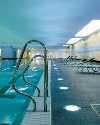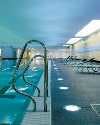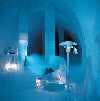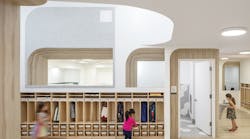Download a PDF version of this article (1.0 MB)
Lighting manufacturers that choose from a range of light sources according to the demands of the fixture and application in question have a unique perspective on the viability of LEDs. LEDs Magazine discussed these issues with Richard Turner of lighting manufacturer Louis Poulsen UK Ltd.
Where are the main applications for LED-based luminaires?
Richard Turner: LEDs tend to be used in indicators and for color-changing applications. Initially, Louis Poulsen used 5-mm LEDs and clear glass covers, and subsequently introduced opaque covers, which provide a uniform distribution of light, as well as surface-mount PLCC-2 devices. These have a wider viewing angle, providing the fixture with much greater visibility, whereas the 5 mm LEDs are more focused. Both these types of LEDs are supplied to us by Stanley Electric.
Where are LEDs less suitable?
RT: When we project light onto the exterior surface of a building, for example, the quality of light isn't quite so important as inside an office, where you start to face issues such as color rendition and color temperature. Where the lamp is used as a light tool rather than as an indicator or a decorative fixture, cost is a critical issue.
Until we get to a point where the efficiencies and lifetimes of LEDs are significantly better, this problem will remain. I don't see LEDs as a lighting tool for interior lighting at the moment.
What other challenges do LEDs face?
RT: The size of the fixture is also an important consideration; in the example above, 120 LEDs would cause significant heat-sinking issues. In the larger products manufactured by our company, we have space to fit more LEDs into the fixtures but we are constrained by thermal issues. We under-run the LEDs with a 50% safety margin - its essential to avoid going near the limits because the LED lifetime starts to plummet.
The issue of binning is less important for exterior lighting, but very important for indoor applications where color temperature is defined. Another issue is that color temperature does not necessarily define color - if the color coordinates are slightly away from the black-body locus, then the color temperature might be as requested but the LEDs will have a color tint that can easily be detected.
What are you looking for from your LED suppliers?
RT: Currently we have different circuit boards for each of the three types of LED that we use, which all require different components. Each of these has standard and DMX color-control options, and each has five colors (amber, blue, green, red and white) that need to be driven differently. This makes 30 circuit boards for each of our 3 main product ranges, and we also have other ranges that use LEDs.
How good are current high-power devices?
RT: One issue is that higher-power LEDs don't perform well in terms of lifetime. In automotive or traffic signal applications, where the LED is only on for short periods of time, you can get away with using a 3 or 5 W device. If you run a 3 W device continuously at that level, the lifetime could be around half the value stated in the data sheets. All measurements are made under laboratory conditions at 25°C and in free air, not inside fittings; as soon you enclose the device you have problems of heat removal.
The Lumileds Luxeon package is not ideal, it's very difficult to mount on a circuit board due to its shape. Other packages, such as Osram's Golden Dragon, are essentially like the PLCC-2, only larger, and these are compatible with automated assembly equipment.
Does LED technology need standardization to increase its acceptance?
RT: LED technology is moving very rapidly at present. If you move towards a plug-and-play solution, then a standard base would be very good; this would allow the luminaire manufacturer to choose which LEDs to use. But because LEDs are so sensitive to heat sinking and other factors, the OEM would probably develop its product around one specific LED. A replacement might not have same heat sinking, and could run into life problems.
From the point of view of a lighting manufacturer such as ourselves, having one LED board per product range will allow us to buy larger batches of LEDs and boards, improve our turnaround times and maintenance service, and reduce our costs. We expect the socket approach to catch on once it is introduced, but right now it's not holding things back - LEDs are increasingly popular, and big projects keep rolling in.










